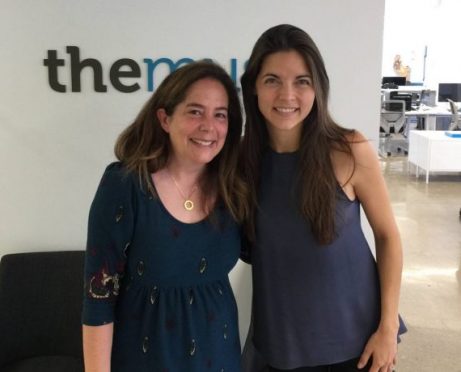
This post originally appeared here on Product 10x, a startup accelerator for early-stage enterprise SaaS startups.
Most entrepreneurs would agree watching your vision come to fruition is a greater reward than the grueling hard work, effort, and sacrifice.
Two entrepreneurs — Suresh Madhuvarsu, managing partner at Product10x, and Doria Lavagnino, co-founder and chief content officer at CentSai, Inc., a financial literacy SaaS company — sit down to talk shop about how CentSai went from concept to reality.
Bringing a Company From Concept to Reality
Suresh Madhuvarsu: Why did you decide to start CentSai?
Doria Lavagnino: My co-founder, Arindam Nag, and I were deeply concerned about the financial illiteracy epidemic in the U.S. and abroad. The Great Recession in 2008 showed that the U.S. government was willing to bail out big banks with taxpayer money while the average American — mired in debt —was left to fend for herself.
My co-founder and I wanted to create a company to educate the so-called “99 percent.” Basic personal finance is not hard, but it’s essential to understand and feel empowered to ask questions about your money.
SM: In your specific role as co-founder and chief content officer, how are you impacting the future of CentSai?
DL: I’d say the success of a company is not based on one or two people, it’s the work of our entire team. Having a bifurcated role as a business owner and a content head requires agility. As a co-founder, I am involved in strategic decisions, prioritization, and the company’s growth. As the head of content, I lead the vision of our content, and I rely on customer feedback to iterate.
SM: What challenges have you faced and how did you work through them?
DL: For one, I did not know how much I did not know about running a business. Here are key lessons.
- Ensure you have an adequate runway because everything takes longer than expected.
- Each investor has his or her own idea of what your business should be. Use what is relevant, but don’t let the rest distract you.
- Running the NYC marathon took less stamina than running a startup. Be 100 percent committed or you won’t survive. Though I am the one who ran the marathon, I credit my co-founder with giving me the strength to never give up.
- Instill process to avoid feeling like you are flying a plane while trying to build it.
- Ensure communication is seamless, not siloed.
Building Teams and Using Tools
SM: Content creation is expensive. How do you build a team at scale?
DL: High-quality content creation is expensive, yet every company needs it whether it’s an article, video, quiz, or trivia. Early on, a prospect asked why we didn’t offshore content creation to reduce cost.
We tried with a few articles. The result? Though the initial cost of the content was less, the time spent editing the copy to adhere to our rigorous editorial standards didn’t make it worthwhile. As a customer, I would rather receive work I can trust.
I spent more than a decade at Condé Nast and Hearst, and my co-founder worked as a reporter, columnist and editor on three continents for the Economic Times, Thomson Reuters, and Dow Jones (publisher of the Wall Street Journal). We both learned from experienced professionals how to properly cover a story.
Today a myriad of bloggers masquerade as trained journalists. There are a handful of solid subject-matter experts online, but why take the risk?
That said, there are a few ways we reduce cost. We focus on evergreen financial pain points, meaning our content is as relevant today as it will be next year. Second, we have a large library of financial articles, videos, and quizzes that we license to clients, giving them the opportunity to have stellar content for a fraction of the original price.
Find Business Tools and Solutions
SM: How do you think SaaS technology is helping CentSai to get to the next level?
DL: SaaS technology is how we scale our content offerings. That’s why SaaS solutions are sexy to investors. They offer an efficient way to get traction and customer feedback, scale, and iterate. Product10x has played a crucial role in helping us build our go-to-market solution on a shoestring budget and product led growth philosophy.
A quality I appreciate about Suresh is — with several exits under his belt — he is a prioritization ninja. It’s easy to get distracted by shiny objects and feature creep. Suresh helped us think through priorities and pivots and their pros and cons.
Product10x helped us to ‘SaaSsify’ our content/core IP, generate multiple revenue channels and improve our overall company valuation.
The Challenges of Growing From Concept to Reality
SM: What’s your advice for young women who want to start a business?
DL: My advice is to understand the gender gap in venture funding is real. Every VC and entrepreneur should be familiar with the work of Dana Kanze and her team. Here is a summary from the Harvard Business Review. Her groundbreaking research quantifies what so many women experience. The good news: Unconscious bias has a solution. I won’t give away her conclusion.
Also, find mentors. If STEM is your jam, go for it. Women are breaking down barriers. As a result, more products and services are made with female consumers in mind.
Last, every time you enter a conference room and you’re assumed to be a notetaker, let that light a fire in your belly.
SM: Can you describe what pivots you have taken and why?
DL: The biggest pivots we took were the result of customer feedback and product market fit. We created a library of content and started as a B2C site for millennials to learn about financial wellness.
The market told us to focus on the financial pain points of people, regardless of their generation.
Our second pivot was to create a B2B SaaS platform — called CentSai One — to license and brand our content to financial professionals, banks, and credit unions. We can provide bespoke or licensed content, and we’ve branched out into building landing pages and web sites for financial institutions or professionals due to market demand.
Our third pivot was to create a curriculum for high school students called CentSai Education. We created and mapped each content asset to a benchmark from the Council for Economic Education.
We listened to the market need for actionable data, so we created pre- and post-assessments for all modules to help quantify success. Our entire curriculum was reviewed by our resident Ph.D. in financial literacy, and initial pilots are positive.
SM: Looking back, what would you do differently? Why?
DL: What I would do differently:
- Embrace a data-driven approach to every decision to avoid “shiny object syndrome.”
- Hire fewer people.
- Focus on quality business development talent sooner.
Looking Forward for CentSai
SM: How do you help your team grow, and why should your team be part of the CentSai story?
DL: Though my co-founder and I are technically the company leaders — we learn from our team so I think it’s a symbiotic relationship. We are lucky to be surrounded by smart passionate people who believe in the mission and are loyal.
To help our team grow, we ensure transparency and an open dialogue. That said, we’re not huge fans of long meetings. They can be productivity killers. We listen to people who are experts in their field. Arindam and I both readily admit we are always learning.
Training, mentoring, and being on a constant learning curve are the cornerstones of our company culture.
SM: What do you see in CentSai’s future?
DL: High level: I aspire to make CentSai content synonymous with quality. Arindam and I want to help make a difference in people’s attitudes and understanding of personal finance. Small and medium-sized banks, credit unions, and financial advisors will have access to compliant, creative content at an affordable price.
In five years, we see CentSai as a global champion for financial literacy. While America is an essential stepping stone to test our solutions, the real impact of CentSai will be felt when millions of people in nations such as India, Mexico, Brazil, and Kenya have easy access to financial literacy via their mobile phones.
While our customers are typically financial institutions, advisors, or non-profits –it’s through these partnerships that we reach the end consumer.
As for the rest, stay tuned for some exciting news in the fall.









![[VIDEO] Be Your Own Boss! Teaching Entrepreneurship to Kids](https://centsai.com/wp-content/uploads/2016/10/teaching-entrepreneurship-to-kids-Daye-Deura-461x372.jpg)